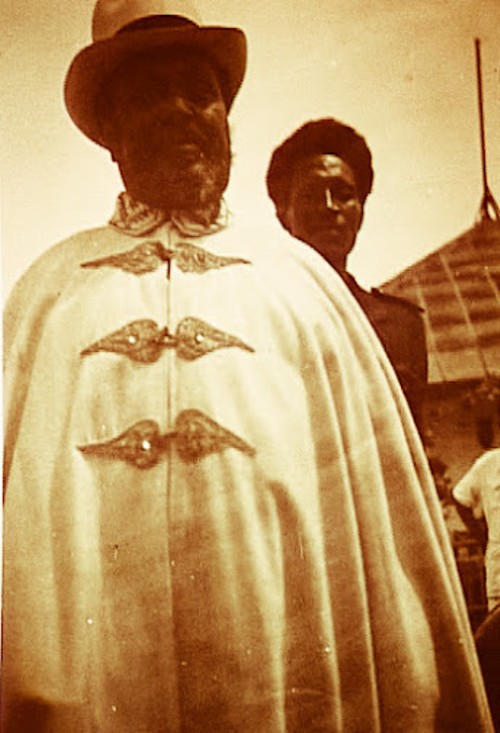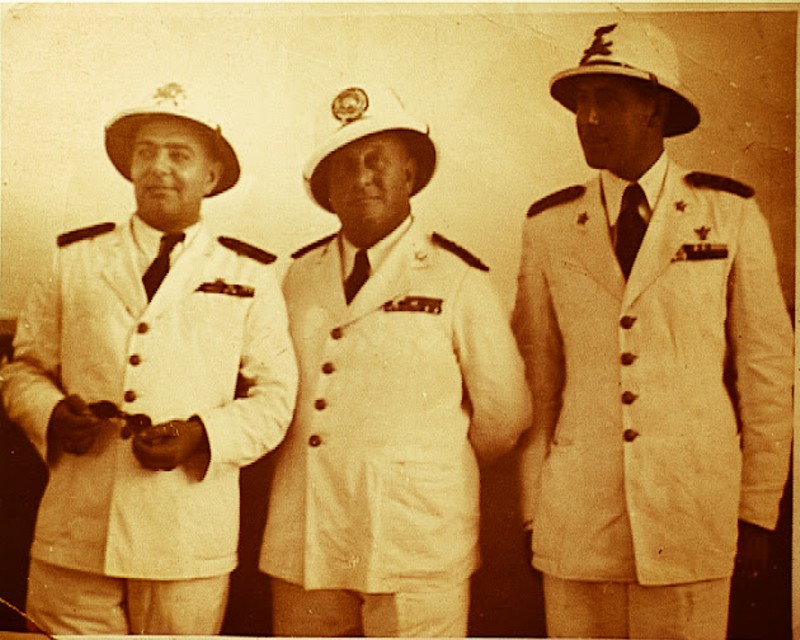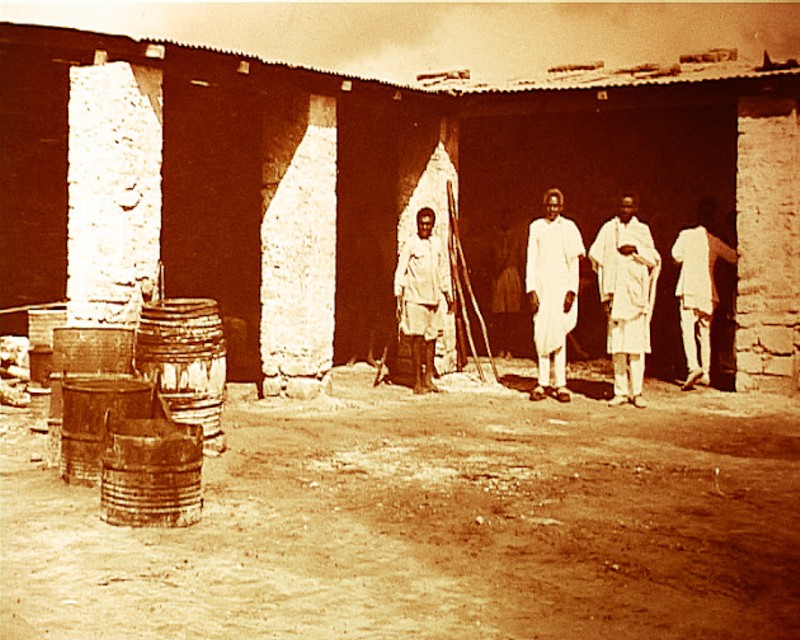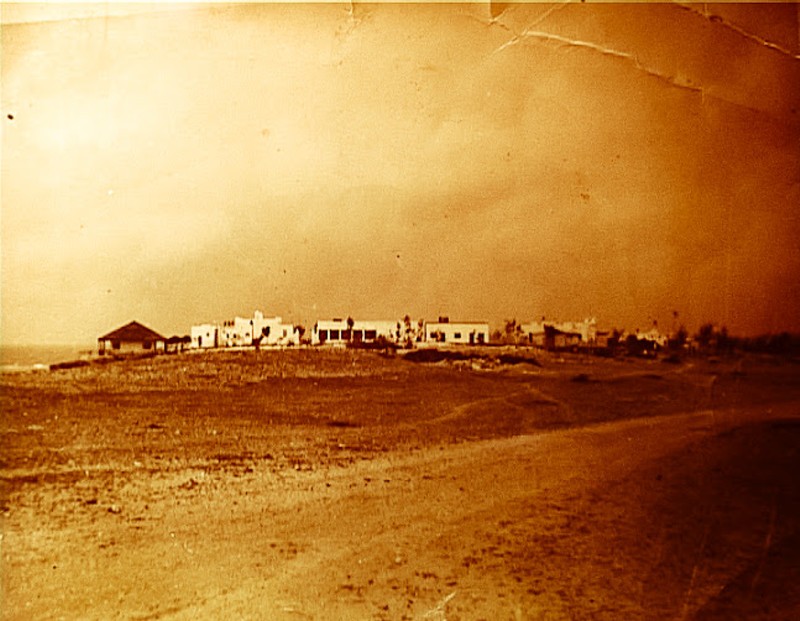There is not much information on these camps but i will show as much as i can find, if anyone else has any further information about this subject or about any of the other camps please tell me
ERITREA
NOCRA CONCENTRATION CAMP
Nocra concentration camp was, at first, set up by the Italians in 1895 but closed in 1930.
The camp was reopened in 1936 for political opponents and POWs. Nocra housed prisoners from Eritrea, Somalia, and Ethiopia, all over the AOI. It was located on Nakura Island.
Michael R. Ebner writes: "Italian authorities deported hundreds of higher-level Ethiopian nobility and functionaries to confino in Italy, while sending other 'ordinary' patriots, intellectuals, educated persons, and their families to concentration camps such as Danane and Nocra."
Upon arrival at the camp, prisoners had to shave their beard and heads, and were also vaccinated against smallpox. The camp lacked proper drinking water, leading to very poor conditions. Prisoners had to do forced labor and work in cement factories and work with oil plants aswell. The conditions were also very hot, with temperatures at Nocra reaching up to 50 degrees celsius. About 1,500 people died at Nocra Concentration Camp.
Jacob Leul, a man who was at Nocra camp from 1938-1940, says:
"The most difficult thing in Nocra was the high temperature. It was 50 degrees in the shade. Every day someone died from heat exhaustion. They forced us to work. Except the four of us, the prisoners had to carry stones and wood, build houses and other hard labor. The four of us, on the other hand, worked in the office.
There were 1,800 prisoners in Nocra, among them 150 politicians. The others were convicted inmates, some common criminals, still others Eritreans who had rebelled against the Italians. We did not get enough drinking water and then many fell ill. Some drank the salty sea water and died. Many have died of dehydration. Political prisoners were forced into hard labor and were whipped if they resisted.
When our family members sent us some money, the Italians only gave us 15 lire a month of that money. We bought food with that money, but many prisoners died from poor nutrition all the same. Many died of so-called "paludism".
The doctor lived in Massawa and came only occasionally. But there was an Ethiopian veterinarian among the prisoners, Alema Work.
The four of us had beds to sleep in, but the other prisoners slept on the bare floor. The treatment of ordinary and political prisoners was the same, they were only separated to sleep.
Once when prisoners were called to take money sent by relatives, an officer ordered them to take off their shoes. Some of them refused because the earth was too hot, and for this they were sent to a cell in the dark for two or three months. The officer was called Captain Bartogli, he was the commander of the prison.
When the veterinarian Alema Work said that the prisoners were sick, the Italians forced them to work anyway.
There were also six women in Nocra, two had arrived with us. They were in a separate area but they received the same treatment as men in regards to food and everything else”.
The camp was liberated and dismantled in 1941 after the British victory at the Battle of Keren and the occupation of Nakura Island, the island which the camp was on.
AGORDAT CONCENTRATION CAMP
There is very little info about this camp. But Italian documents from 1935 show that the camp was located 25 km along the Cheren road, near Adograt. Conditions of the camp, victims, and testimonies are unknown. Again, if anyone has further information, please share.
ADI UGRA CAMP
The Adi Ugri camp was set up in October 1935 following the Italian Invasion of Ethiopia. It was located in Adi Ugri, Eritrea.
The camp housed POWs. It was referred to as a "Concentration Camp" in a telegram from the head of the Adua Political Bureau under the command of the Carabinieri:
"By order of the Chief of Staff, I send to this Command, to be interned in the concentration camp of Adi Ugri, the indigenous woman Mesellac Gheremedhin and three children, respectively wife and three children of the cascì ghebez of the church of Mariàm Sciauìto, Gheremariam Mariam Innatù."
This could have possibly been referring to Adi Ugra POW camp, or another concentration camp in Adi Ugra.
The camp was dismantled in May 1936.
ASSAB CONCENTRATION CAMP
The Assab concentration camp was built in 1898 by the Italians but shut down in February 1899.
The camp was reestablished by the fascists later. Italian and Eritrean civilians were interned, most of the prisoners being political prisoners and resistors. Many of the inmates died at Assab, and it was one of the worst concentration camps in Eritrea.
TT, a man who was born in Eritrea in 1920, says:
“During the Italian colonialism there was also opposition; there were several leaders who protested, and who were then arrested and confined to prisons in the Dahlak Islands, or even in Assab. Many have never returned; I have no details, but the whole world knows that opponents and those who engaged in political activity have been relegated to the islands. My family was also against the Italians. I remember, when I was seven, my father was arrested and confined to Assab , for political reasons. He was relegated for a year and after numerous prayers and following the intervention of the heads of the Bizen monastery he was finally released."
SOMALILAND
ROCCA LITTORIO CONCENTRATION CAMP
There is little info about this camp
This was a camp set up for Ethiopian Elites. The camp was located in Gaalkacyo, Somalia.
OBBIA CONCENTRATION CAMP
This camp was for prisoners who threatened the instability of the Italian regime.
The camp was located in Hobyaa, Somalia.
ITALA CONCENTRATION CAMP
This camp was for people who were less dangerous to the Fascist regime. It was located in Adale, Somalia.
Inmates were allowed to recieve visits from family members.
MOICO FORCED LABOR CAMP
This was a forced labor camp set up between 1938-40. It was located in Moico, Somalia, northwest of Mogadishu. The camp was dependant on the Danane concentration camp which will be discussed later.
Inmates at the camp took part in the construction of the Mogadishu-Villabruzzi railway line and did other forced labor.
Eugenio Mazzucchetti, the commander of the Danane camp, says this:
"The Moico camp will be expanded by enclosing three huts and including two service huts in the enclosure. The surveillance will be entrusted to the Gogle of the residence in the camp. From the SAIS security guards on the works. The new camp will be administered by men from the Residence.
The SAIS will pass L. 5 for each confined per day. What remains beyond the cost of food will be given as compensation to the confined. I tried to fix a fixed wage per day, but I couldn't. I predict that the inmates will flee because they are not happy with the treatment. I mentioned this both to the Direz. OO.PP. than to SAIS and to the Residence, but in vain."
MOGADISHU CONCENTRATION CAMP
This camp was set up by Guglielmo Nasi and his forces in April 1936. It was located in Mogadishu, Somalia.
The Italians under Nasi immediately sent 500 prisoners to the Mogadishu camp. Later on, the Elderly, women, and children would be sent to the camp too. According to Irma Taddia's testimony, 2,500 people were sent to the camp after Yekatit 12. It existed until 1939.
DANANE CONCENTRATION CAMP
This is probably the most well known of the camps in AOI. There is lots of info on it.
Danane concentration camp was originally set up in 1935 for political prisoners, but after Yekatit 12, civilians and ethiopians who refused to collaborate with the Fascist regime. Through 1937, hundreds of people were sent to the Danane Concentration Camp.
Prisoners had to do forced labor. Women at the camp were forced to clean up the camp, while men had to search for wood, do garden work, and build roads.
Malaria and pneumonia were common diseases in the camp, and the camp was very humid aswell. Inmates were punished for even the smallest mistakes, and there was torture, interrogation, and other brutal punishment in Danane. For instance, guards often punished prisoners by hanging their feet to a wall where they were unable to touch the ground.
The food consisted of biscuits, worms, or white rice. Water was unclean and polluted, and prisoners often had to drink sea water, resulting in mass deaths. In total, about 49% of the people who went to Danane concentration camp died.
Here is a testimony from Michael Tessema, who was in Danane for about 3 years:
"Three inmates had to live together in a tent designed for a single soldier. They gave us nothing, no clothes, no sheets, not even rugs to use as mattresses.
Initially, the food consisted of biscuits. We drank sea water, so 6 to 30 people died daily. Overall 3,175 died. I became aware of these figures, because I worked as a prisoner as a medical assistant and kept records of the dead.
Until the end, the Italian authorities did not provide us with drinking water. 3,175 out of 6,500 people died in Danane.
Not all of them died because some received money from their relatives and bought bottled mineral water brought from Italy and fermented milk from Somalis.
After a year they gave us bread, pasta, rice, tea and meat once a week. [...]
The staff employed in the camp included about sixty Europeans. Among them the sergeant Baroni, the sergeant Tosato and a marshal of the carabinieri whose name I do not remember. They whipped prisoners saying they would not respond to greetings, or that they did not work hard.
Work in the field included cleaning, going to a place called a canal for garden work, collecting firewood, and building roads. Women and men who refused to work or who were too weak were tied and hung on a wall, with their feet dangling. They remained like this for seven days. Due to this, two people's arms swelled and were amputated.
If the prisoners got sick, Captain Antonio said it would be better for them to die. And he killed them with an injection of strychnine and arsenic. Others, who came for treatment, were tied to their beds and operated against their will ”.
There are many photos of the Danane concentration camp aswell. Here are just a few

Ethiopian general Ras Seyoum at the camp

Two women at Danane

Cafeteria at the camp

Mazzucchetti, the commander of the camp, with others at Danane

Inmates at Danane

Woman with a baby at Danane

Picture of Danane from the outside

GENALE FORCED LABOR CAMP
Genale was a forced labor camp dependant on Danane concentration camp. It was located in Janaale, Somalia.
360 prisoners were sent to the camp after its construction. Inmates were forced to build water canals and do other forced labor.
Some prisoners managed to escape the camp, but they often arrived at other concentration camps, exhausted and sick. 2,000 new prisoners were sent to the camp in April 1940.
ETHIOPIA
HARAR CONCENTRATION CAMP
The Harar concentration camp was set up by Nasi on orders from Rodolfo Graziani after Yekatit 12.
Nasi and his forces did police operations near Harar and took 4,000 Ethiopians to Harar. The Italians forced some people in the camp to enlist as soldiers. The conditions in the camp were horrid. Consider this account from Michael Blatta Bekele Hapte, who was in the camp for 3 days:
“There were a lot of Ethiopian internees in Harar. They gave us black bread to eat. There was only one latrine for nearly 200 prisoners. There was no air to breathe, almost suffocating.
We could not get food from any inmate who wanted to help us. For example, a prisoner named Ato Hawash gave some of the food he received from relatives to some other inmates. A brigadier, when he saw the boy carrying the food, took it, tied his hands and hung it from the ceiling of the latrine for 24 hours ” (cf. TMB1 ).
[“ When we arrived at Harar also, we were put among-many other Ethiopian prisoners. There we were given black bread for our main meal. Moreover there was one latrine in that prison for nearly 200 prisoners. The prisoners were deprived of air and were suffering from such a suffocating condition.
It was prohibited for us to receive any kind of food from any sympathetic person who might know us. Once a prisoner called Ato Hawash sent to his fellow-prisoners some provisions which were sent to him from his home; an Italian brigadier saw the boy who brought the provisions and tied both his hands together and hanged him from the ceiling, of the latrine for 24 hours."
DIRE DAWA CONCENTRATION CAMP
This was a camp in Dire Dawa, Ethiopia. It was set up in 1937.
There was a severe lack of water, and the prisoners ate biscuits. After the failed Italian Invasion of Greece, the Italians sent Greeks in the AOI to Dire Dawa and other camps in Ethiopia. Malaria and Diarrhea were common diseases at this camp.
Here is Michael Tessema's testimony of the camp.
He was at the camp for about 3 days
“ All the prisoners were terrified of the lack of water. I asked a sergeant to buy me a bottle of mineral water for 500 lire, money that I had managed to hide. But the sergeant took pity on me, and gave me a bottle. However, he did so in secret, so as not to be seen by the other carabinieri "(see TMT1 ).
[" All the prisoner; were tormented by lack of drinking water. I myself told a sergeant to buy me water for 500 liras from the money which I kept in secret, but the sergeant felt pity for me and brought me a bottle of water without accepting the money. When he did this, he was wriggling on his stomach, to avoid being seen by the Carabinieri "].
The food consisted of biscuits.
There were many Ethiopians interned in the camp. 36 hours after my arrival they loaded us on trucks, it was midnight, to take us to Italian Somalia. I heard a colonel say that the convoy's trucks were over 800 ”(see TMT1 ).
[In Dire Dawa there were many Ethiopians confined. After 36 hours, at midnight, we were put on trucks and taken to Italian Somaliland. I heard a Colonel saying that the trucks (lorries) in the convoy were more than 800]"
HURSO-SURCAMA CONCENTRATION CAMP
This was a concentration camp for foreign citizens of AOI. The prisoners at the camp were suspected of anti-Italian actions in AOI.
In November 1940, the camp had 16 internees, but this grew to 82 in January 1941. The camp had majority Greeks.
SHANO CONCENTRATION CAMP
This was a camp East of Addis Ababa. The camp operated from 1936-41.
It was the site of mass executions. The Italians would fill the camp with Ethiopian civilians, massacre them all, and then fill the camp and do the same at a later date.
Many of the internees were transferred to Nocra and Danane.
BUSHEL CONCENTRATION CAMP
This camp was located in Mojo, Ethiopia. The camp was for Ethiopian government officials and religious leaders.
Nasi ordered for people to be sent to Bushel Concentration Camp in a document in 1940.

Here is a testimony from Kidan Blatta Haile Wolde, who spent time at the camp:
"My house in Chafe Donsa was surrounded by 300 Italian soldiers. So it was that they arrested me.
They took me to Moggio where they put me in a small tucul together with eight other inmates. The tucul measured five by three meters. It was terrible, suffocating.
Later other prisoners arrived and put them with us. We were all standing, leaning on each other.
If an inmate died, they left the body inside the prison for three or four days.
Also because of the harmful insects, the living conditions were terrible. The daily mortality due to disease was greater than that due to killings by Italians.
In July 1937, the Italians brought elders, priests, monks and nuns from Zuquala to the camp. They placed them in an area near the river, unprotected from the rains. Therefore many of them died of diseases and the others were shot ”(cf. TKB1 ).
[“ While I was still in my house at Chafe Donsa, 300 Italian soldiers surrounded my house and arrested me.
From there they took me to Moggio. When I arrived at Moggio I was put in a little hut among eighty prisoners in a room which measured 3 by 5 meters [roughly 10 feet by 16 feet]. The conditions were horrible and stifling.
Afterwards they brought other prisoners and put them among us, and for this reason we used to stand on one another.
When a prisoner died, his body used to he kept for three or four days in the prison.
Because of the noxious insects which prevailed in the prison the conditions were terrible. The number of deaths in this prison daily was higher than those who were murdered by the Italians.
In the month of Hamle, 1929 (EC), the Italians brought monks, nuns, aged, deacons and feeble persons by donkey from Zuquala to Moggio. There they were put in an enclosure near the river without shelter from the rain and on marshy ground. For this reason many of them died from sickness, and the rest were shot "
AKAKI CONCENTRATION CAMP
This camp was located 16 km south of Addis Ababa.
It housed military leaders aswell as women, children, and the elderly.
The food consisted of Biscuits and Water. Several Ethiopian women at the camp were stripped naked and both men and women were beaten by Italian officials.
Imru Zelleke, who spent time at the camp after Yekatit 12, describes his experience as follows:
“Hundreds of prisoners were brought there from all over Ethiopia. Many of them were country people and simple peasants. They didn't know what was happening and why they were there. The camp was a sort of sorting center where prisoners were selected to be subsequently sent to other prisons and concentration camps.
We were crammed into large military tents, with no amenities, and slept on the floor without blankets.
Nothing strange happened in that field, except for an accident: an Italian sentry shot a pregnant woman to death with a bayonet. The woman and her husband were farmers, a couple who never left their village, so they didn't understand the reason for their detention. The woman, who wanted to leave, went to the gate of the camp to ask for information, but since it was very dark, when the sentry saw this large woman approaching, she was so frightened that he stabbed her with his bayonet. Her husband, a certain Wolde-Gabriel , lost the light of reason and suddenly became very violent. He was chained and sent to Danane , where, still chained, screaming and barking all over the field, he died after a few months.
They kept us in Akaki camp for about a week. In early March 1937, they began sending inmates to various destinations. Some groups were brought to Italy, a small number of intellectuals were sent to Nocra , in the Dahlak Islands, the worst prison of all. The bulk of Akaki's prisoners were sent to the Danane concentration camp in Somalia, we were in the latter group."
AMBO CONCENTRATION CAMP
The Ambo camp, located in Ambo, Ethiopia, was very similar to the Shano camp.
It was also used for mass executions, which took place between 1936-41.
QUORAM CONCENTRATION CAMP
There is little info on this camp, but it was located in Korem, Ethiopia.
There is one instance where a Greek man who was at the camp was hospitalized, as described in Italian documents.
SOURCES:
http://campifascisti.it/scheda_campo.php?id_campo=48
Michael R. Ebner. Geoff Simons. Ordinary Violence in Mussolini's Italy. New York, New York, USA: Cambridge University Press, 2011. P. 261
http://campifascisti.it/file/media/Test ... 20Leul.pdf
http://campifascisti.it/scheda_provvedi ... &id_pro=78
http://campifascisti.it/scheda_campo.php?id_campo=429
http://campifascisti.it/scheda_campo.php?id_campo=190
http://campifascisti.it/scheda_campo.php?id_campo=277
http://campifascisti.it/scheda_campo.php?id_campo=52
http://campifascisti.it/scheda_campo.php?id_campo=53
http://campifascisti.it/scheda_campo.php?id_campo=265
http://campifascisti.it/scheda_campo.php?id_campo=272
http://campifascisti.it/file/media/Test ... chetti.pdf
http://campifascisti.it/scheda_campo.php?id_campo=181
http://campifascisti.it/scheda_campo.php?id_campo=49
http://campifascisti.it/file/media/Test ... elleke.pdf
http://campifascisti.it/elenco_immagini.php
http://campifascisti.it/scheda_campo.php?id_campo=156
http://campifascisti.it/scheda_campo.php?id_campo=121
http://campifascisti.it/file/media/Test ... 0Hapte.pdf
http://campifascisti.it/scheda_campo.php?id_campo=117
http://campifascisti.it/scheda_campo.php?id_campo=1245
http://campifascisti.it/documento_doc.php?n=2249
http://campifascisti.it/scheda_campo.php?id_campo=182
http://campifascisti.it/scheda_campo.php?id_campo=119
http://campifascisti.it/file/media/Test ... 0Wolde.pdf
http://campifascisti.it/scheda_campo.php?id_campo=114
http://campifascisti.it/scheda_campo.php?id_campo=183
http://campifascisti.it/scheda_campo.php?id_campo=1015
http://campifascisti.it/documento.php?n=2250